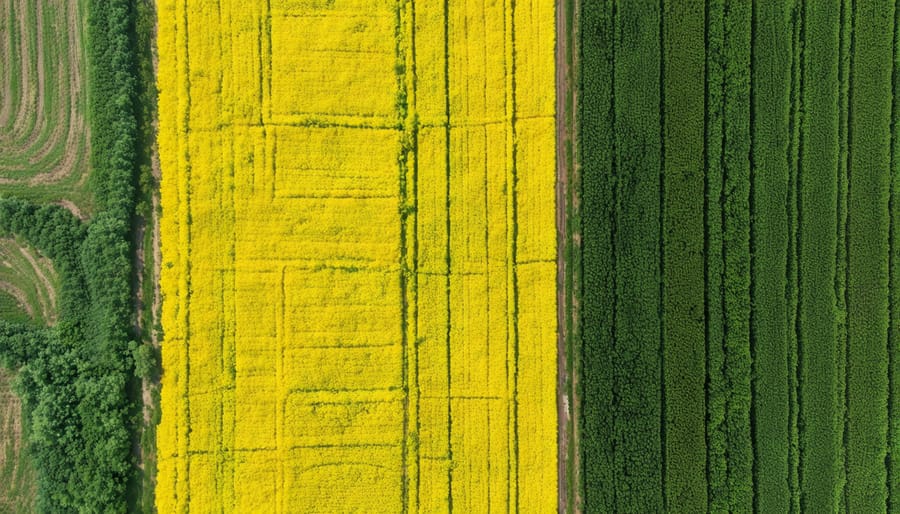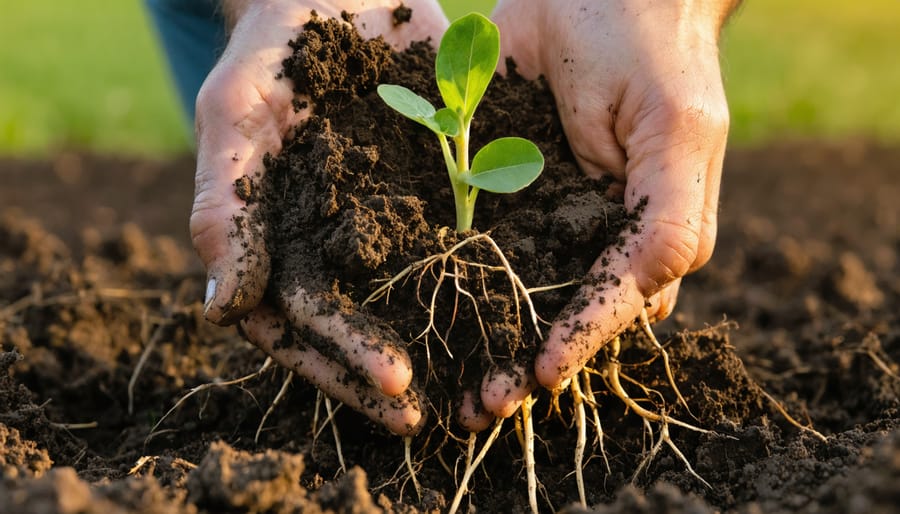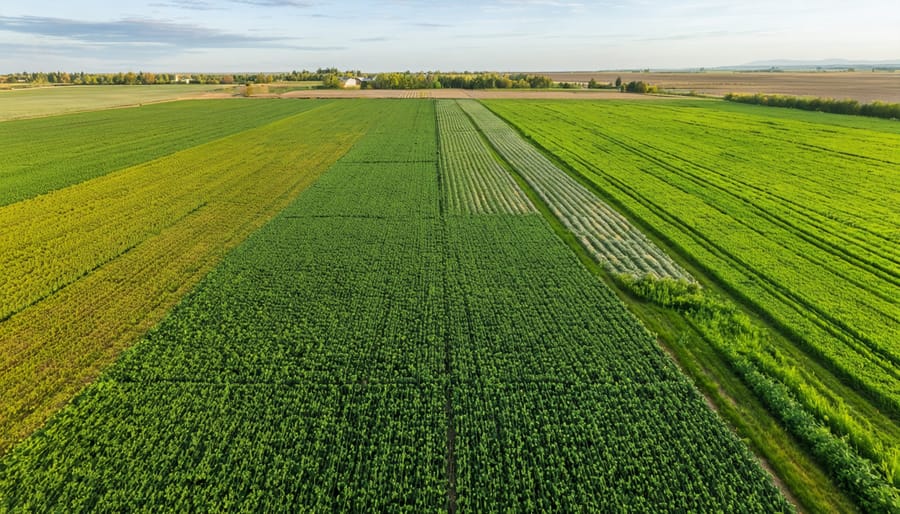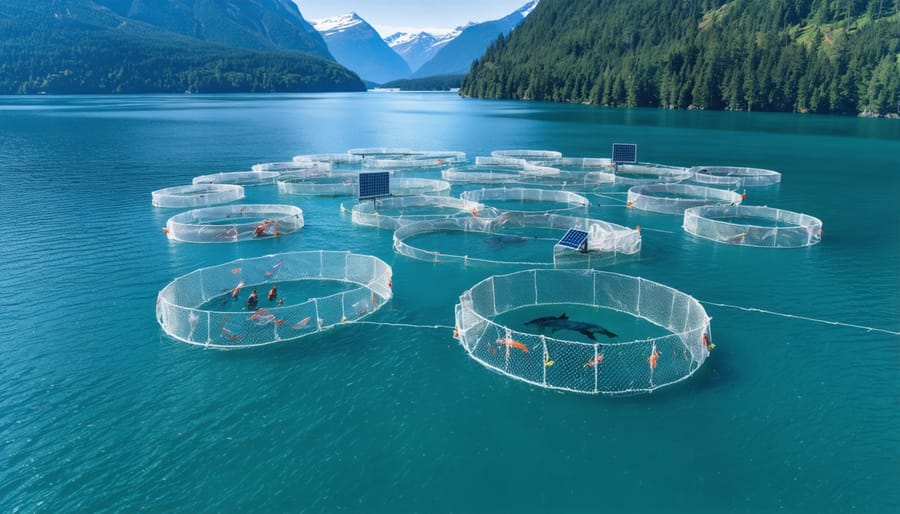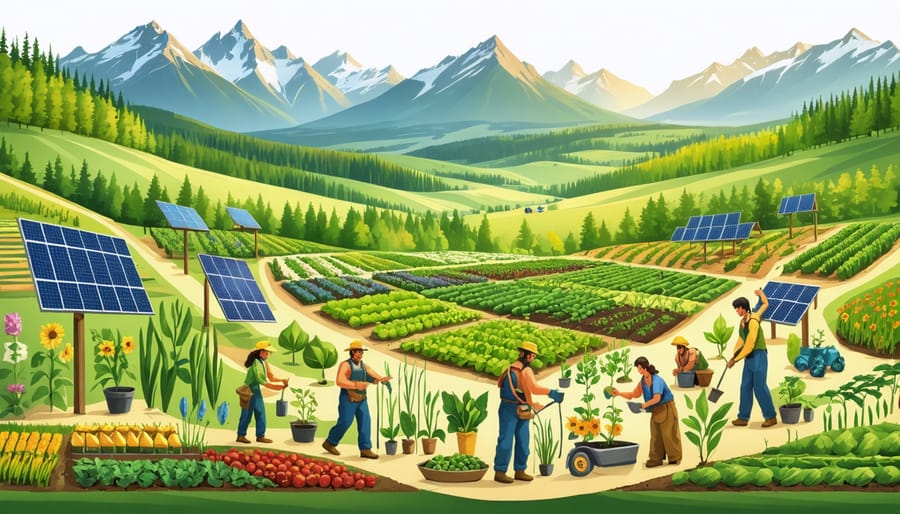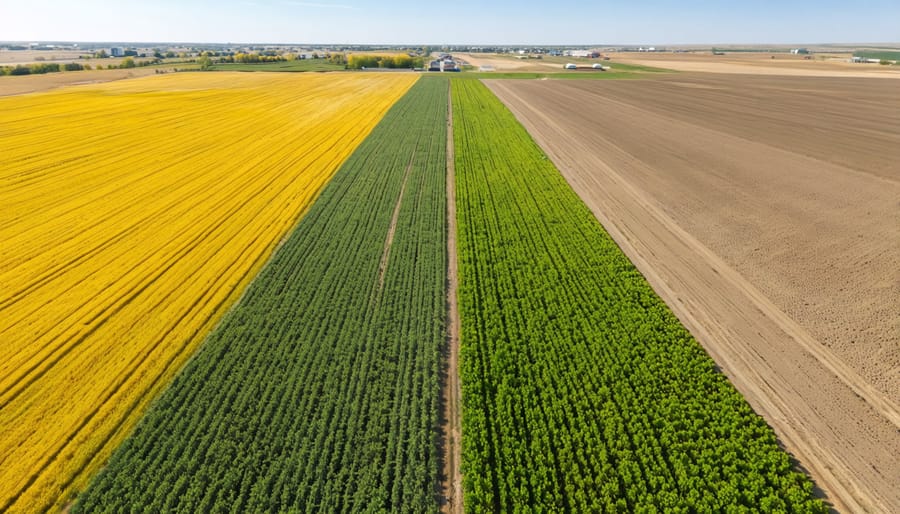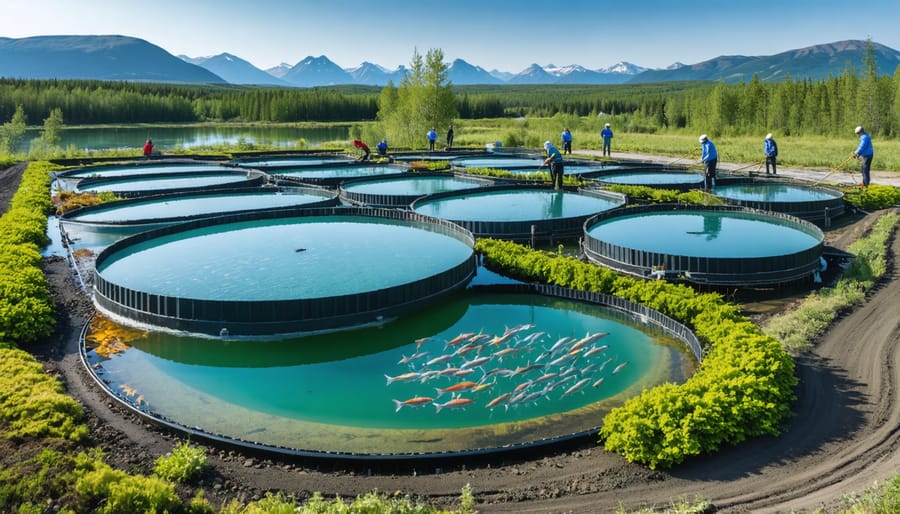Over the past fifty years, industrial agriculture has fundamentally transformed Canada’s food production landscape, creating a stark trade-off between efficiency and biodiversity. From Alberta’s wheat fields to Ontario’s corn belt, the shift toward large-scale monocultures, intensive livestock operations, and chemical-dependent farming has dramatically reduced the variety of plants, animals, and microorganisms that once thrived on Canadian farmland. This loss affects not just wild species, but also our agricultural heritage – we’ve lost over 75% of crop genetic diversity since 1900, with many heritage varieties of wheat, beans, and vegetables disappearing from our fields. The standardization of livestock breeds has similarly narrowed the genetic pool, with just five commercial cattle breeds now dominating Alberta’s ranches. Beyond the visible losses, industrial farming practices have degraded soil biodiversity, reducing the complex web of organisms that naturally support healthy crop production. Yet, understanding these impacts is the first step toward change – Canadian farmers are increasingly pioneering solutions that balance productive agriculture with biodiversity conservation, proving that feeding our growing population doesn’t have to come at the expense of our natural heritage.
The Hidden Cost of Monoculture Farming in Canada
Lost Prairie Grain Varieties
The Canadian Prairies once cultivated a rich tapestry of heritage grain varieties, each adapted to specific local conditions. Records from the 1900s show that Alberta farmers grew over 200 distinct wheat varieties, including the hardy Red Fife and the drought-resistant Marquis. Today, less than a dozen varieties dominate our commercial wheat production.
Notable losses include the Purple Spring wheat, known for its exceptional frost tolerance and unique purplish hue, and the early-maturing Reward wheat that thrived in Alberta’s shorter growing seasons. The Garnet wheat variety, celebrated for its superior baking qualities and resistance to local plant diseases, disappeared from fields by the 1960s.
Third-generation farmer Tom Anderson from Camrose recalls, “My grandfather used to grow three different types of wheat on our farm, each suited to different field conditions. Now we’re limited to just one variety that fits the industrial specifications.”
This narrowing of grain diversity stems from standardization demands of large-scale farming and processing. While these modern varieties offer consistent yields and uniform characteristics, their dominance has left our agricultural system more vulnerable to climate stresses and disease outbreaks. Some seed saving networks are now working to preserve remaining heritage varieties, but many unique Prairie grains have been lost to time.
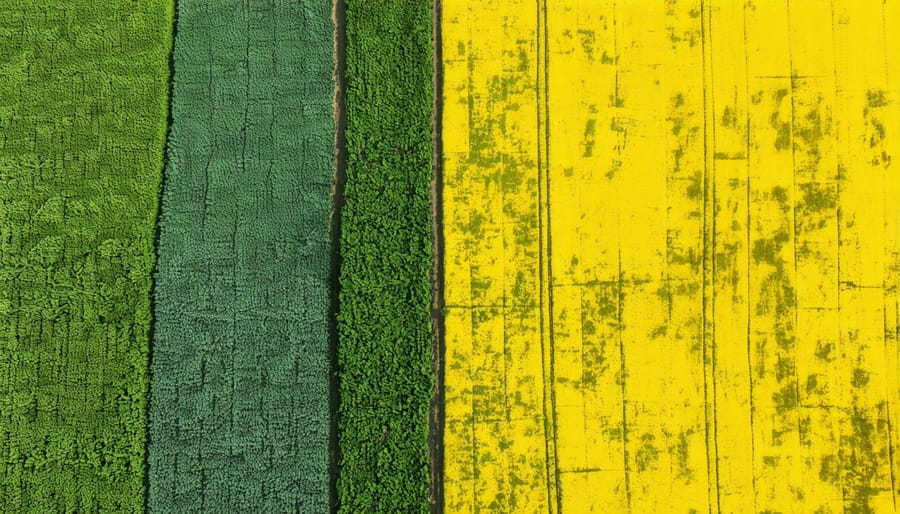
The Canola Dominance Effect
The transformation of Alberta’s agricultural landscape over the past three decades tells a compelling story of how market forces can reshape crop diversity in Alberta. Since the 1990s, canola has emerged as the dominant crop, with its footprint expanding from 2.5 million hectares to over 6 million hectares today. While this shift has brought significant economic benefits, it has also led to a notable decline in the cultivation of traditional crops like wheat, barley, and oats.
Local agricultural records show that where farmers once rotated between 5-6 different crops, many now alternate primarily between canola and wheat. This simplified rotation pattern, while efficient for large-scale production, has reduced the genetic diversity of our agricultural systems. Small-scale farmers report that market pressures and processing infrastructure increasingly favor canola production, making it challenging to maintain diverse crop portfolios.
The dominance of canola has also influenced seed saving practices, with many farmers now relying on a handful of commercial varieties rather than maintaining local seed diversity. However, some innovative producers are working to preserve heritage crop varieties alongside their canola fields, demonstrating that economic viability and biodiversity can coexist with thoughtful planning.
Industrial Livestock Production’s Impact on Genetic Diversity
The Narrowing Gene Pool of Canadian Cattle
Over the past fifty years, the Canadian cattle industry has experienced a concerning narrowing of its genetic base, particularly in Alberta’s beef and dairy sectors. According to the Canadian Cattle Genetics Association, more than 65% of our dairy cattle now descend from just five main breeding lines, compared to over thirty distinct lineages in the 1960s.
This genetic bottleneck stems largely from the industry’s focus on maximizing production traits like milk yield and growth rate. While these characteristics have helped meet rising demand, they’ve come at the cost of genetic diversity that historically provided natural disease resistance and adaptability to local conditions.
Ralph Anderson, a third-generation cattle rancher from Olds, Alberta, shares his perspective: “When I started farming with my father in the 1970s, we had several hardy local breeds that thrived in our winter conditions. Now, most farmers use the same handful of commercial breeds.”
The impact extends beyond individual farms. Recent studies from the University of Alberta show that decreased genetic diversity has made our national herd more vulnerable to emerging diseases and climate stresses. However, forward-thinking farmers are taking action by participating in heritage breed conservation programs and exploring cross-breeding strategies to reintroduce genetic variation.
Several Alberta breeding cooperatives now maintain seed banks of diverse cattle genetics, ensuring these valuable traits remain available for future generations of Canadian farmers.
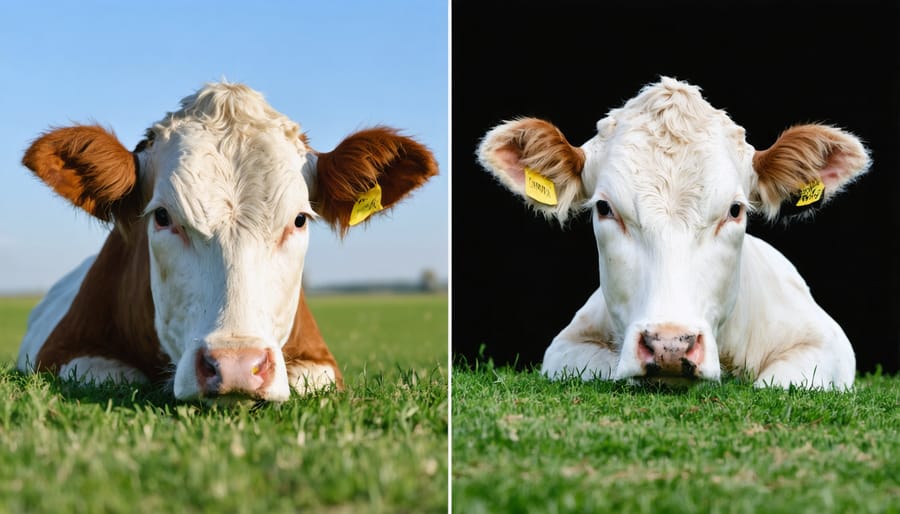
Heritage Breeds at Risk
Traditional Canadian livestock breeds, which once thrived on family farms across the country, are increasingly at risk of disappearing. The Canadienne cattle, developed in Quebec during the 1600s and known for their remarkable adaptability to harsh winters, have dwindled to fewer than 1,000 breeding females. Similarly, the Newfoundland Pony, perfectly suited to our maritime climate, has declined from 12,000 in the 1970s to just over 250 today.
These heritage breeds face extinction primarily due to industrial farming’s preference for high-yield commercial breeds. For instance, the Holstein-Friesian now dominates our dairy industry, while traditional dual-purpose breeds like the Lynch Lineback are barely hanging on. In Alberta, the Lacombe pig, developed at the Lacombe Research Station and praised for its hardiness, has been largely replaced by commercial hybrid lines.
However, these heritage breeds carry invaluable genetic traits that could prove crucial for future food security. The Chantecler chicken, Canada’s first recognized breed, demonstrates exceptional cold tolerance and good egg production without artificial heat – traits that could become increasingly important as we adapt to climate change.
Local farmers are making a difference through conservation breeding programs. The MacDonald family in Red Deer, for example, maintains a small herd of Galloway cattle, preserving these efficient grazers for future generations while proving that heritage breeds can still be economically viable in modern farming operations.
Soil Biodiversity Under Threat
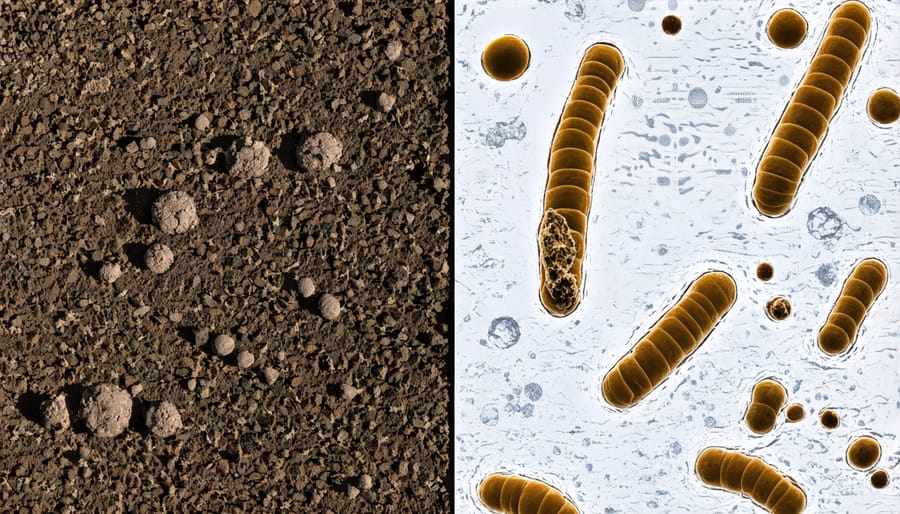
Chemical Inputs and Soil Life
The widespread use of chemical pesticides and synthetic fertilizers in industrial agriculture has significantly impacted soil health and biodiversity across Alberta’s farmlands. These inputs, while initially boosting crop yields, have disrupted the delicate balance of soil ecosystems that naturally support plant growth. Recent studies from the University of Alberta show that repeated applications of broad-spectrum pesticides reduce beneficial microorganism populations by up to 50% in treated fields.
Synthetic fertilizers, particularly those high in nitrogen, can alter soil chemistry and reduce the diversity of mycorrhizal fungi – crucial partners in nutrient cycling and plant health. Many Alberta farmers have noticed earthworm populations declining in fields with heavy chemical use, indicating broader impacts on soil fauna. Traditional Indigenous farming practices in the region historically maintained rich soil ecosystems without synthetic inputs, demonstrating that productive agriculture is possible while preserving soil life.
Local soil testing services have documented decreased organic matter content in conventionally managed fields compared to those using reduced chemical inputs, suggesting a connection between intensive chemical use and soil degradation.
Prairie Soil Health Crisis
Recent soil surveys across Alberta’s agricultural regions reveal a concerning decline in soil biodiversity. Testing conducted by the University of Alberta shows that intensive farming practices have reduced essential soil microorganisms by up to 70% in some areas compared to native prairie soils. These microscopic organisms, including beneficial bacteria, fungi, and earthworms, are crucial for maintaining healthy soil structure and nutrient cycling.
Local farmer Greg Thompson from Ponoka County notes, “Twenty years ago, you’d dig up a spadeful of soil and find dozens of earthworms. Now, we’re lucky to spot even a few.” This observation reflects a broader trend across the prairies, where conventional tillage and heavy chemical use have disrupted natural soil ecosystems.
The Alberta Soil Health Coalition reports that reduced soil biodiversity directly impacts crop yields, with affected fields requiring up to 30% more synthetic fertilizers to maintain production levels. However, farmers implementing regenerative practices are seeing promising results. For example, farms using cover crops and reduced tillage have reported up to 40% increases in beneficial soil organisms within three years, demonstrating that recovery is possible with appropriate management strategies.
Solutions from Alberta’s Organic Farmers
Seed Saving Success Stories
In Alberta’s Pembina Valley, Sarah Thompson’s family farm has successfully preserved heritage wheat varieties for three generations. Working with Seeds of Diversity Canada, they’ve maintained a seed bank of over 20 different wheat cultivars, including Red Fife and Marquis wheat, varieties that helped build Canada’s agricultural foundation.
The Calgary Seed Library, established in 2015, has grown into a thriving community hub where over 500 local gardeners and farmers exchange and preserve traditional vegetable varieties. Their collection includes drought-resistant bean varieties and cold-hardy tomatoes specifically adapted to Alberta’s climate.
In Red Deer County, the Indigenous Seed Keepers Network has made remarkable progress in preserving traditional First Nations crop varieties. Their work includes saving seeds from traditional corn varieties and maintaining local squash cultivars that have been grown in the region for centuries.
The Organic Alberta Seed Exchange program has documented significant success in maintaining crop diversity. In 2022, they facilitated the exchange of more than 1,000 distinct seed varieties among Alberta farmers, ensuring these important genetic resources remain viable and accessible to the farming community.
These initiatives demonstrate how local action can effectively preserve agricultural biodiversity. Many participating farmers report increased crop resilience and better adaptation to local growing conditions, proving that maintaining genetic diversity has practical benefits beyond conservation.
Building Better Soil Biology
Building healthy soil biology starts with reducing tillage and minimizing chemical inputs that can harm beneficial microorganisms. Many Alberta farmers have found success with cover cropping, using diverse species like clover, vetch, and rye to protect and feed soil life between main crop cycles.
Crop rotation is another powerful tool for enhancing soil biodiversity. The Organic Alberta demonstration farm in Lacombe showed that rotating cereals with pulse crops increased earthworm populations by 40% over three years. These beneficial organisms create vital soil structure and cycle nutrients naturally.
Composting and applying organic amendments helps reintroduce beneficial microbes. Local success stories include a Red Deer County farm that improved soil organic matter by 2% in five years through annual compost applications. Many producers also use livestock integration, with managed grazing providing natural fertilization while stimulating root growth and microbial activity.
Creating undisturbed field margins and maintaining permanent grass strips between cropland provides habitat for beneficial insects and soil organisms. These zones act as reservoirs of biodiversity that can recolonize working fields.
Remember that rebuilding soil biology takes time. Start with small test plots to experiment with different techniques. Connect with other farmers through local soil health networks to share experiences and learn what works best in your specific conditions. The key is making consistent changes that promote life underground.
The impact of industrialized food production on biodiversity loss is clear, but together, we can make positive changes in our agricultural practices. Throughout Alberta and across Canada, farmers are already leading the way in implementing sustainable agricultural practices that protect and enhance biodiversity. By diversifying crop rotations, maintaining natural habitats, and reducing chemical inputs, we can create resilient farming systems that support both wildlife and productive agriculture.
The path forward requires a community effort. Consider starting with small changes on your farm, such as introducing cover crops or establishing wildlife corridors. Connect with local agricultural extension services and fellow farmers who have successfully integrated biodiversity-friendly practices. Remember, every hectare managed with biodiversity in mind contributes to the bigger picture of environmental stewardship.
Let’s work together to ensure our agricultural legacy is one of abundance – not just in yields, but in the variety of life that makes our farms truly sustainable. Your actions today will help shape the future of Canadian agriculture and preserve our precious biodiversity for generations to come.

